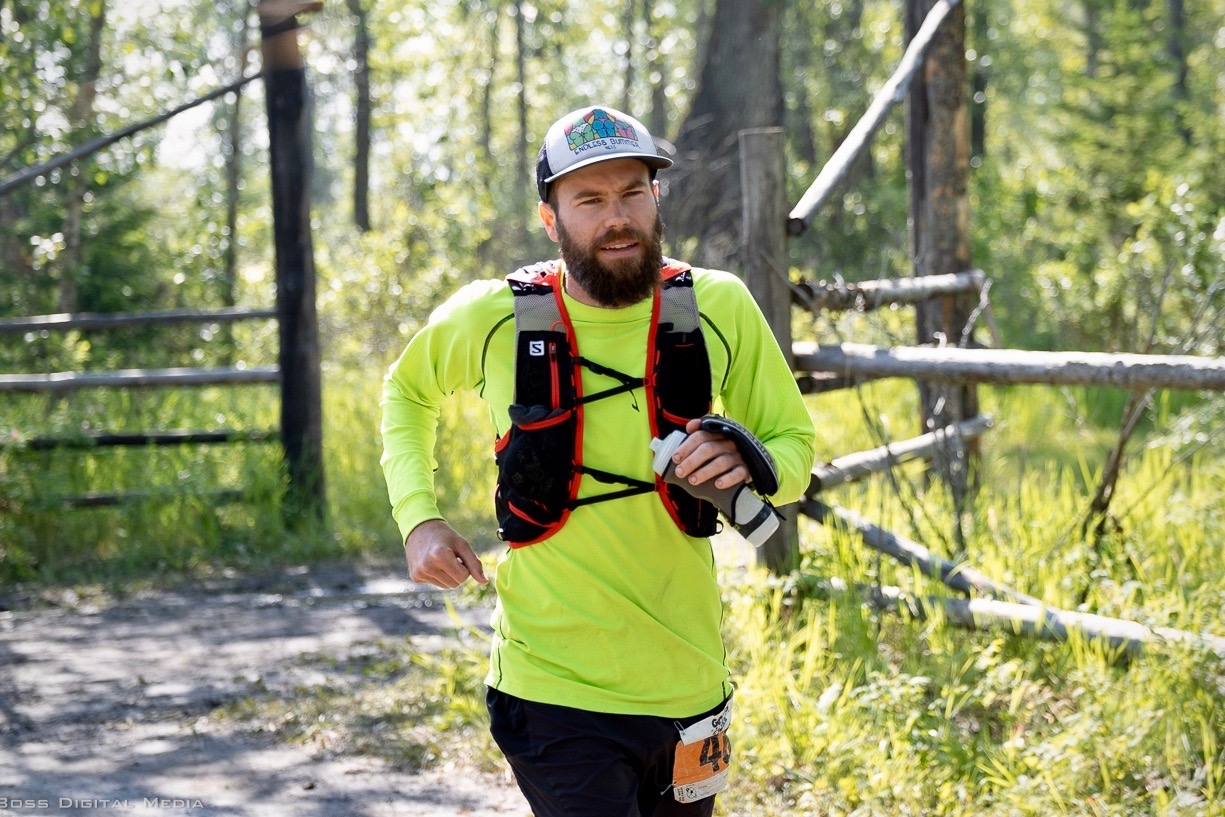It was still raining when we woke up. Ella had slept in her tent and came to knock on the door of the van. It was around 8am. In two hours, the Outrun Backyard Ultra was going to begin. I’d slept terribly, not quite sure if I’d actually been sleeping or just lying there. We made some coffee and ate some breakfast and then prepared for the start of the race. I was wearing rain pants, a rain jacket, a garbage bag over my torso, and a wide brim hat to keep the rain out of my face. The trash bag was Ella’s idea. We called ourselves “Team Trash ‘n’ Dash”. At 9:30am, we were all invited to the main race area for a pre-race talk. Race director Dave Proctor said a few words and then introduced honorary race director, “Lazarus Lake”, the creator of the “backyard” race format and the infamous Barkley Marathons. He shared some advice. “I know some of you are aiming for some intermediate distances,” he said with a smile. “From what I’ve seen, the race doesn’t begin until day two.” A 100 mile “warm up” — how charming. Within minutes, we were all herded into the starting corral, and at 10am, Laz rang his soon to be familiar cow bell and we began the first loop.
The course was a simple out and back punctuated at the halfway point by a lollipop around a horse track. Though the course was fairly straightforward, it was difficult to visualize exactly where we were running. I looked for key landmarks that I could develop into pace markings. There were 150 of us out there, so things were tight on the trails and focus was required to avoid getting in someone’s way. By comparison, Laz invites only 75 runners to Big’s Backyard Ultra, the original race in Tennessee. There was no reason to rush ahead, but it was still a challenge to find your groove.
I know some of you are aiming for some intermediate distances. From what I've seen, the race doesn’t begin until day two.
— Laz
Towards the end of the first loop, I was on pace for about 45 minutes, so I slowed down and walked the last 500m for a 50 minute loop. Ella came in a couple minutes behind me and we compared notes. I felt fine, but mentally, there was no way I was going to do that 23 more times. So much for my “A” goal. We sat for a few minutes and our core temperatures dropped quickly. My gloves had wet through and my hands were freezing. Soon we heard three whistles signifying we had three minutes before the start of the second loop. A minute later, two whistles. A minute after that, the final whistle giving us a minute to get into the corral. Laz rang his cow bell and we were off again.
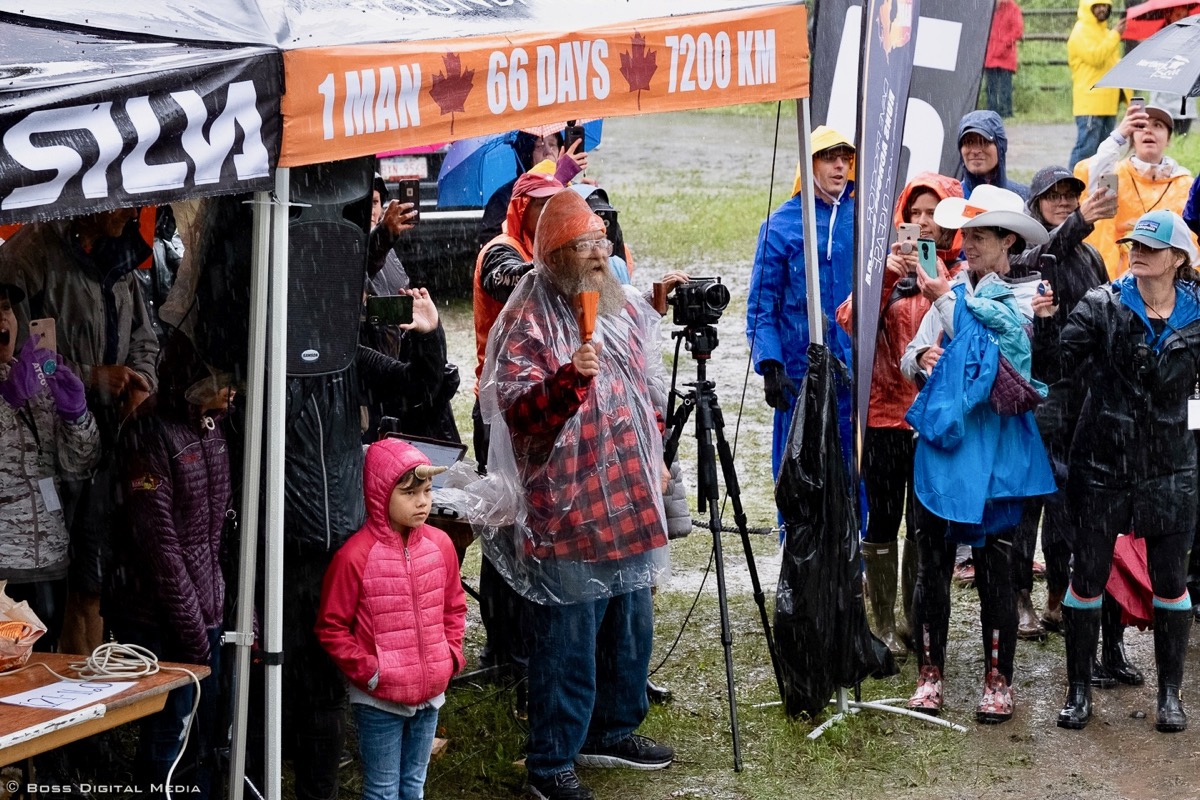
Laz and his bell. For more insight into Laz’s character and wry sense of humour, Good Luck, Morons, is a great read
The mud on the trails was thick, and even thicker on the horse track. With every step, your feet disappeared into cold, soggy holes. Some people walked the track, some ran, other tried to find better footing on the inside and outside walls of the oval where small patches of firm ground still remained. I found I slipped less if I ran through the middle, but it was hard going. With 150 pairs of feet on the trail, and most sections of the course getting hit twice per loop, the mud only got worse as the day wore on. Complete focus was required to avoid slipping.
Given the cold weather, there was little incentive to run fast as it would mean more time sitting at camp, getting cold. Both Ella and I slowed our pace down, aiming for something in the 50-55 minute range, providing just enough time for a snack and a water refill before setting off again. Even though those first few loops were pretty miserable, there was a great feeling of camaraderie amongst the runners. While many people there had run ultras before, this format was new to all of us. It was exciting.
As the rain wore on, the trash bag strategy proved successful. I looked ridiculous, but it was working; my hands were cold, but I was otherwise pretty cozy. Plus the look earned me the nick name of “Trash Man” from the spectators and course volunteers. Over time I settled into a rhythm using parts of the course at pace guides. A typical loop went something like this:
10 minutes to the ridge.
Walk break.
20 minutes to the trees.
Walk break.
30 minutes around the track.
Another walk break. The worst is over.
40 minutes to the far side of the blue tent.
45 minutes to the road.
Another loop down.
In between loops, our wonderful crew chief, Megan, plied us with warm tea and fielded our requests for food and articles of clothing. There wasn’t a single loop in which Ella or I didn’t have some kind of request for her — always something to tweak. This was Megan’s first time at an ultra, so before the race I had explained all the things that could go wrong and how to best avoid them. I also shared with her the playful truism that CREW stands for “Cranky Runner, Endless Waiting”. As it turned out, Megan was a natural. She was patient, understanding and attentive. She knew as the race wore on, I would become irritable and reluctant to eat, but she never pushed anything too hard.
When Megan wasn’t tending to food and gear requests, she was handling “social media” business, keeping friends and family apprised of the action. My friends Brock and Jordan started sending over motivational videos that Megan would show me while I sat in my chair. The videos were such a wonderful and unexpected surprise. Brock got really into it and I was soon watching a new video every couple of hours featuring chants of “Trash man! Trash man!” It was heartwarming and encouraging.
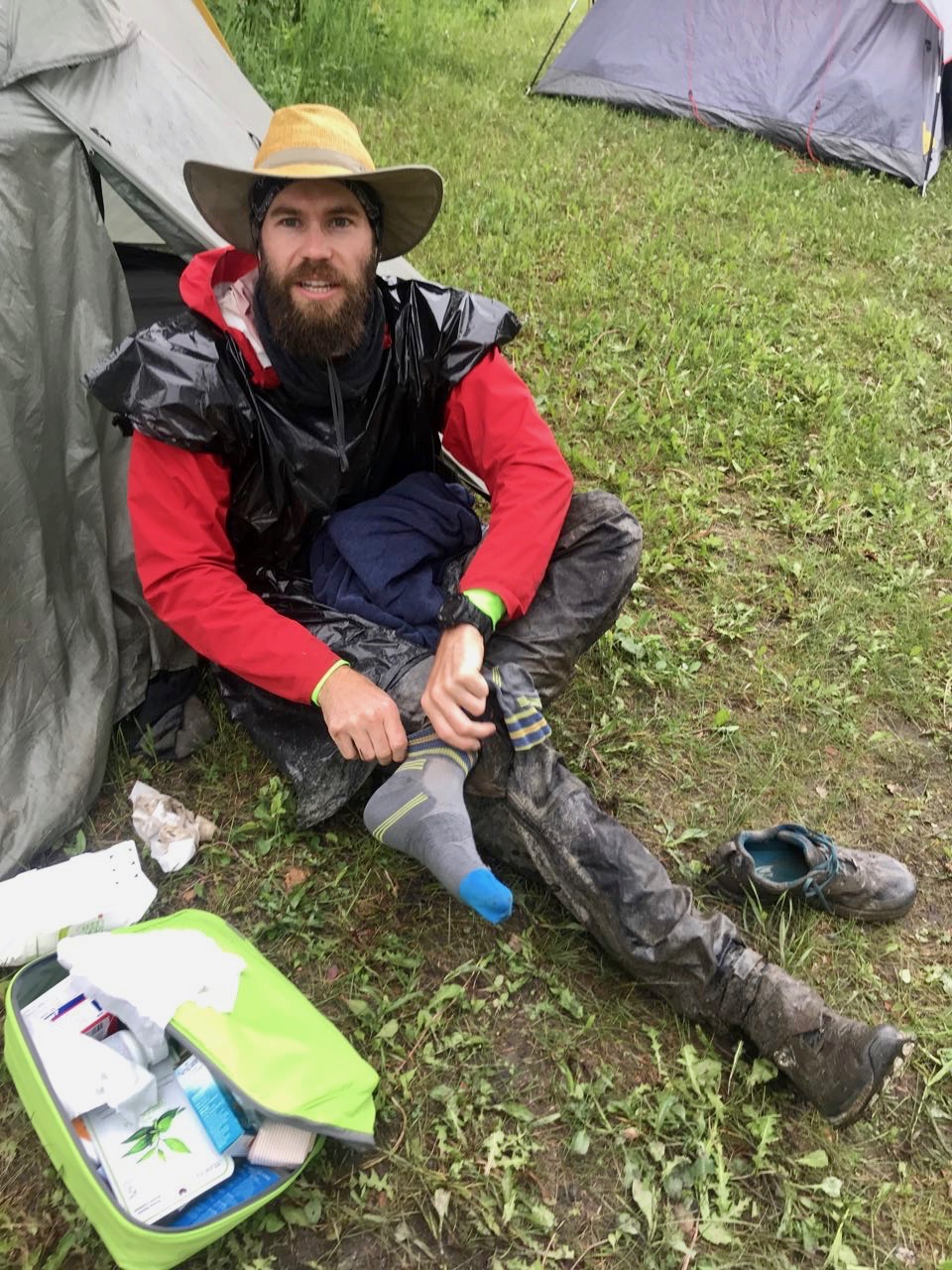
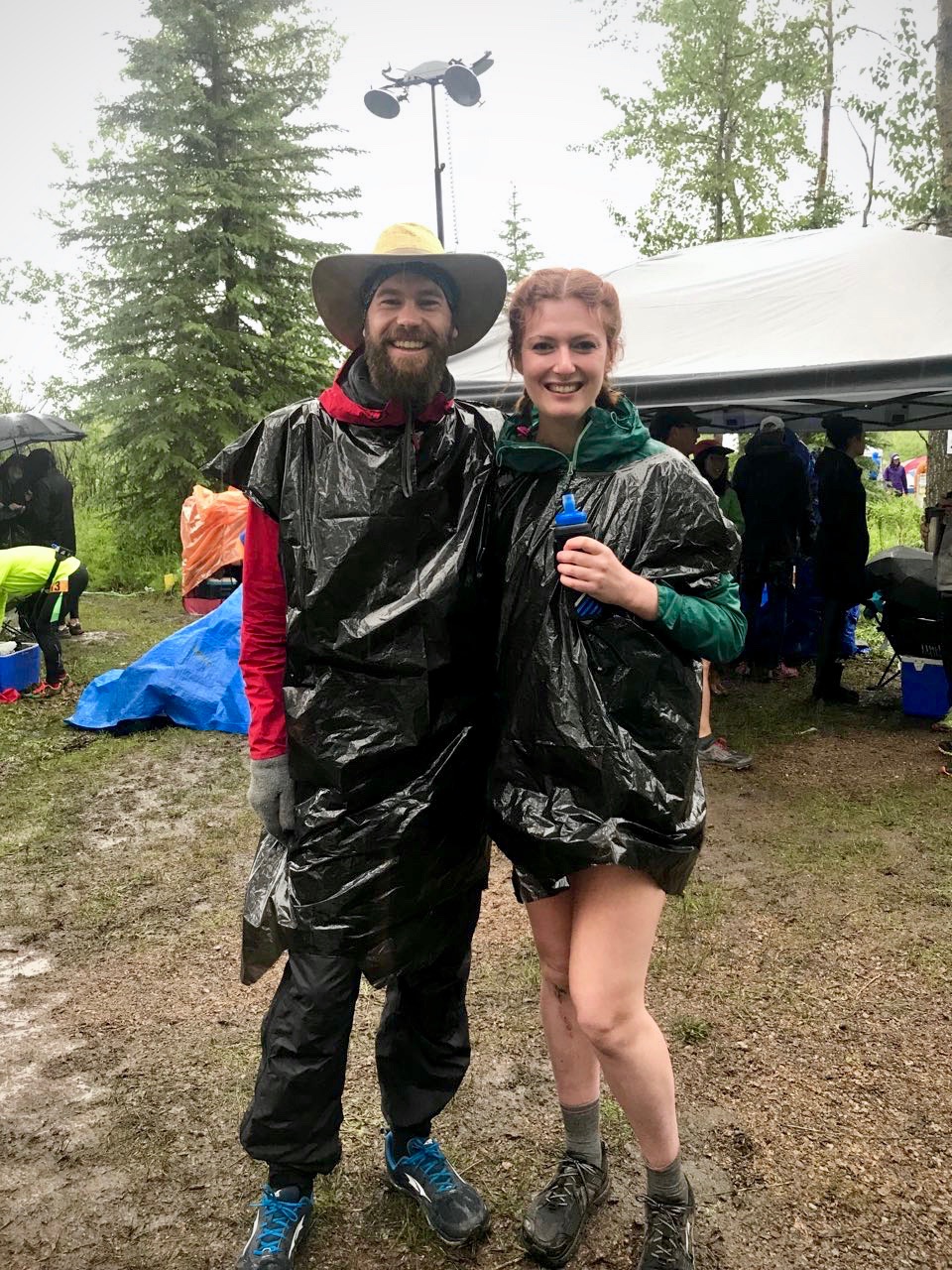
Despite the monotony, no loop was exactly the same. The weather gods teased us with breaks in the clouds and the mud would dry up slightly, then it would rain again and get even muddier. People would drop each time around, creating more space out on the trails. Volunteers and supporters would pop up at different positions around the course. The differences between each lap were subtle, but distinguishable. The only constant was the satisfaction of running back to the main tent where you exchanged your race number for a checkmark on the official race sheet, marking another successful loop.
Ella, Megan and I had done a great job of pre-race planning. The only logistical part that didn’t work well was coordinating movement between the van, our chairs and our tents. As a few savvier runners near us had figured out, you ideally want all your stuff in one spot. Eventually we migrated the chairs to the tent area, but Megan still had to walk back and forth to the van to prepare hot food.
There were 45 of us remaining at the end of the 10th loop when the spell of bad weather finally broke. It looked like the night portion wasn’t going to be as miserable as I had imagined. Ella and I had been consistently running splits about 5 minutes apart all day, but as the night started to fall, she was coming in closer and closer to the cutoff. I was hoping she would bounce back but it was clear it wasn’t her day and she eventually dropped on the 12th loop. Low points are normal in ultras, but in traditional race formats you can hang out at an aid station until you rebound. The backyard format isn’t so forgiving.
A few minutes before 10pm, the final glimpses of the sun streaked across the skyline and we were informed that headlamps were mandatory for the next loop. Dave, the race director, also announced a course change due to a flooded river that had dangerously spread across a portion of the trail. He instructed us to follow him into the night to learn the new route we would be running for the remainder of the race. We were 80km (50 miles) in and down to about 20 runners.
I was feeling surprisingly strong and almost excited to begin the night time loops. With the improved weather, I finally took off my stiff rain pants and swapped out my mud caked shoes. I traded the flat brimmed hat for a trucker hat I’d bought years ago on the PCT that read “Endless Bummer” across the front. It seemed like a fitting motto for this Sisyphean suffer-fest.
The new course proved to be a blessing physically, but it was even more monotonous than the original route. We moved onto the grass on the inside of the race track and no longer had to battle the mud, but a single lap around the track had become six, with a short out and back to the starting area. We were now running loops of loops. The only interesting part was the poker chip system. Every time you went around the track, a volunteer gave you a chip to put into your pocket. Once you had six, you could return the start. Running back to the starting corral with your chips in hand was oddly satisfying. Instead of simply checking in at the main tent, you got to lay your chips on the table like a pearl diver returning to the the surface with a precious find.
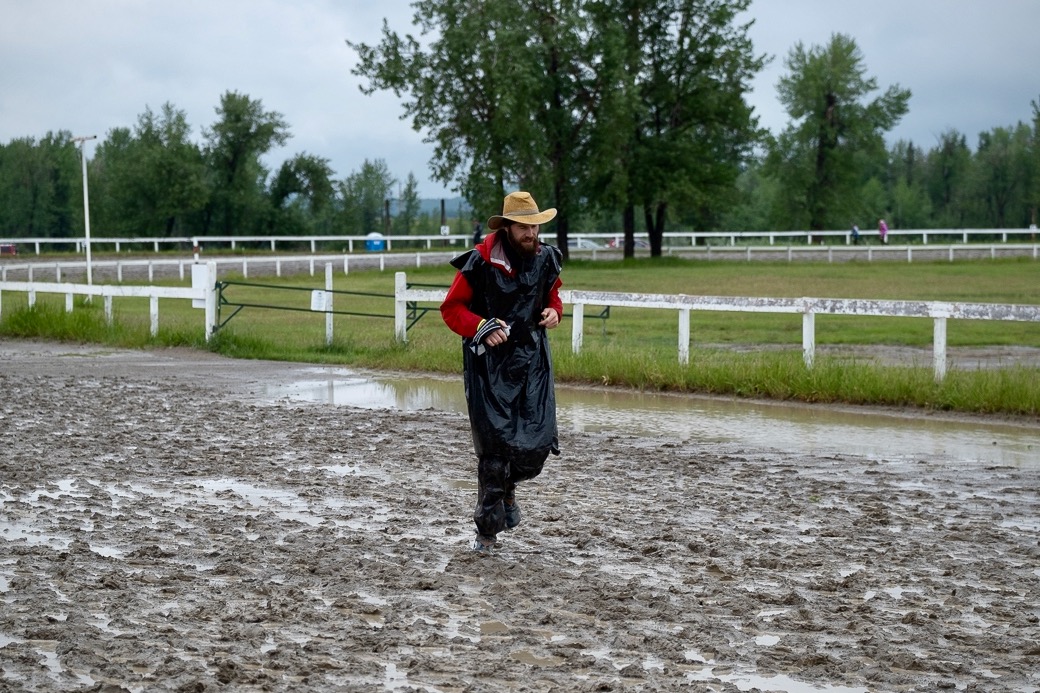
Slogging through the horse track, section I nicknamed ‘the slop’
The inside of my thighs started to hurt around loop 14. All the lateral movement sliding in the mud earlier in the day had put an unusual strain on those little used muscles. I took an ibuprofen, but my stomach quickly disagreed. It numbed the pain in my legs, but eating became a challenge. It’s a rare thing to have everything going for you in an ultra. So much of the sport is about managing something, and today was no exception.
The 100km mark — 15 loops — was a goal for many runners. 17 of us completed loop 15, and then six people suddenly dropped. Some had reached their goal, others surrendered to compounding of various niggling issues, and a couple were saving themselves for other races in the weeks that followed. There were 11 of us in the starting corral for loop 16. It was 2am. We plodded around the race track, collecting our six poker chips, one loop at a time. To onlookers, they would just see headlamps slowly orbiting the oval. It was surprisingly peaceful. I became friendly with some of the other runners including a guy from the Vancouver area named Kevin. We would chat from time to time as we leapfrogged each other, but like many of the others, I was mostly listening to music, just trying to stay awake.
By the time I got to loop 18, I was starting to fade. I had run the previous lap with a dying headlamp and my eyelids were getting droopy. The next loop with new batteries was better but my lack of food was starting to take its toll. I wanted to sleep. During the break before loop 19, I drank some tea and ate some soup, then tried to close my eyes before setting off again. I put on some upbeat music when out on the course. Everything helped a little. By loop 20, we’d run 134km (83 miles) and my legs were hurting again. My stomach was in knots so Megan gave me a Pepto-Bismol tablet, which helped a little bit, but I needed to eat some real food. I was still confident I could hang on to reach my goal, but I was struggling more than I wanted to admit.
The interesting thing was that despite the challenges during the night, I was consistently the second one back to the starting area. Only Matt, who had been zipping around the course all day, was finishing faster. It became clear he was getting some proper rest, maybe even sleep, in between the loops. It was tempting to copy his strategy, but I was hesitant to change what had been working for me. I was running around most of the oval and taking deliberate walk breaks, never at risk of getting timed out. Four more of our kin dropped between loops 16 and 20, and we were down to the final six. I was firmly in the top 10, but I was fixated on hitting 100 miles.
We were back in the corral getting ready for loop 21 as the sun started to rise. Laz made a comment that loop 21 would be easier than loop 20. “Easier my ass, Laz!” I yelled as I ran by, setting off towards the horse track. The amount of sunlight increased by the minute on that loop and halfway through, I felt a surge of energy, finishing with one of my fastest splits of the day. Laz was right — of course he was. He’d watched runners do this through two sunrises in Tennessee! When I returned to the starting area, I humbly admitted to him that I may have spoken too soon.
The sunlight had given me a second wind but my inner thighs were on fire. I asked Megan for another ibuprofen. I was willing to trade a happy belly for some numbing action. Loop 22 was hard, but my splits were on point. Loop 23 was the first really challenging loop. The fatigue was manageable, but my thigh pain was cutting through the ibuprofen — it did not want to be ignored. It was a grind, but I was so close to my goal that there was never a thought of quitting ahead of schedule.
We were five strong at the start of the 24th loop. Two of the other guys appeared to be struggling much more than I was, but Kevin and Matt were looking remarkably strong. Neither of them had plans to quit anytime soon and were in it to win. I tried not to focus on them. All I wanted was one more loop to complete my goal. It was 9am and the sun was shining. I was in range.
That 24th loop was painful, but it was a mental challenge more than anything. I was a little behind my splits but not terribly so. I was still mostly running, but the lack of sleep was getting to me. Still, I knew I had 24 in the bag, which made me smile — it was almost over. That feeling of satisfaction, however, was soon replaced by fear. I was terrified of the thought that Megan and Ella would push me to keep going. Of course they would! Part of our pre-game strategy involved motivation techniques, but we hadn’t made a plan for after 100 miles. Was I allowed to quit if I was still comfortably making the cutoffs? The mantra, “Die in the field, not in the chair”, came to mind. I really wanted to quit. How glorious it would be to sit down in a chair and stay there for as long as I wanted. I had earned the right to quit, I told myself. No one could stop me! It was a weird headspace to be in.
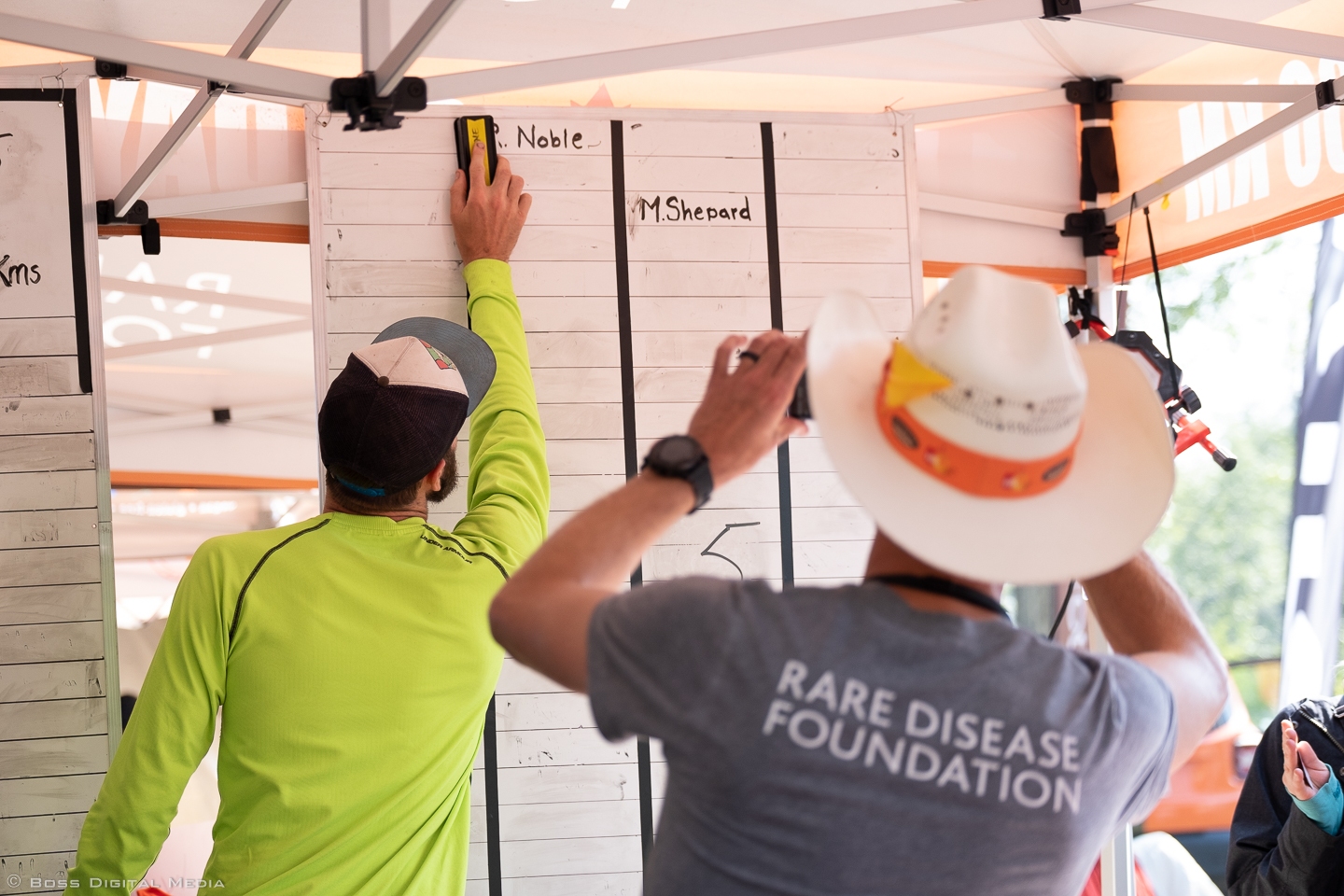
Erasing my name from the big white board to earn my ‘DNF’
When I arrived back at camp, I told Ella and Megan I was done, but they weren’t having any of it. The whistles blew for the start of loop 25, and they got me into starting corral. For a minute there I actually thought I was going to do another lap. How weak could I be? I was supposed to be quitting, and here was I was submitting to peer pressure. Eventually I gained my composure and moments before Laz rang the cow bell for the next loop, I congratulated the other guys and called it quits. Without realizing, one of the others had also dropped meaning we’d tied for fourth. Only three ventured out on that next loop.
It was a bittersweet feeling. I had reached my goal with flying colours, but I was still out of the race. I think I had couple more loops in me but they were going to be even more miserable than the last two. Judging by Matt’s dominance of the race so far, I knew I wasn’t in any shape to win and the different between 3rd and 5th place wasn’t nearly enticing enough to continue on. But mentally, I just wasn’t ready to venture into that new unknown. As Laz later shared, to really be successful in this format, you can’t set a goal or it will be your undoing once you reach it.
Derek, one of the other runners, had been finishing his loops close to the cut offs. He lasted one more loop before he got timed out and finished in third place. After a brief rest inside my tent, we moved our chairs to the main event area to watch Matt and Kevin duke it out for the win. What ensued was one of the most bizarre and heartwarming displays of athleticism I’d ever seen, but it requires a little bit of a back story.
As mentioned earlier, Big’s Backyard Ultra, is limited to only 75 runners, primarily hand picked by Laz based on his private selection criteria. Laz appears to have a savant-like ability to read people’s character. Both of his races (the other being Barkley) are invitation only, and he seems to be more interested in heart and grit over pure athleticism. The only exception to this invite-only rule is the introduction of the “golden ticket” system which started this year. After last year’s spike in popularity, backyard events have popped up all over the world. Laz set up a satellite qualification system that would select the best performances — in terms of distance — from difference regions across the globe. North America, for example, had two tickets available for The Big Show.
What makes this particularly interesting is that the rules of the backyard format stipulate that once a single runner remains, the race is over. Even if that final runner wants to keep going, they cannot. You’re only as good as your competition. The Outrun Backyard Ultra was the second last qualifier of the season, and performance to beat was 31 loops, set at a race in Ohio a couple months earlier. This meant to guarantee a spot at Big’s, you not only had to win the race, but you had to complete at least 32 loops.
As we watched Matt and Kevin set off each hour, the previously quiet campground came back to life as spectators watched to see if one of them would reach 32 loops. By the end of loop 28, it was 2pm and they’d run 187km (116mi). While Matt continued to zoom around the track, it became clear that Kevin was struggling. The physiotherapists on site tended to his sore muscles, but when the final whistle was blown, he was back in the corral for another go.
As we watched this transpire, word got around that Kevin and Matt had made an agreement: Kevin promised Matt he wasn’t going to quit until he reached 31 loops, giving Matt the opportunity to go to Big’s. Kevin knew he wasn’t going to win, but decided to sacrifice his body to help a guy he’d only met the day before. Kevin’s wife — who was crewing him — tried to act supportive, but she was far from thrilled by his suicidal oath. At the risk of seriously hurting himself, there was no doubt that this could go awry, but it was also such a moving display of altruism, I couldn’t help but cheer him on.
Loop after loop, Kevin persevered until the start of the crucial 31st loop. We learned that Matt had been running extra laps around the horse track to help his buddy get to the end. What a strange event this had become! They set off on the 31st loop, and we waited eagerly to see if two would return. With five minutes to spare, the two of them rounded the corner into the campground and we all stood up and cheered them on. There was no doubt that Matt was ready for his victory lap, but for some added drama, Kevin lined up in the corral for loop 32. When the cow bell rang, he pretended to race off with Matt before stopping short, sporting a big smile. He could final rest. Matt zoomed around the horse track in a cool 40 minutes for loop 32, earning his coveted “golden ticket” to Big’s Backyard Ultra this October.
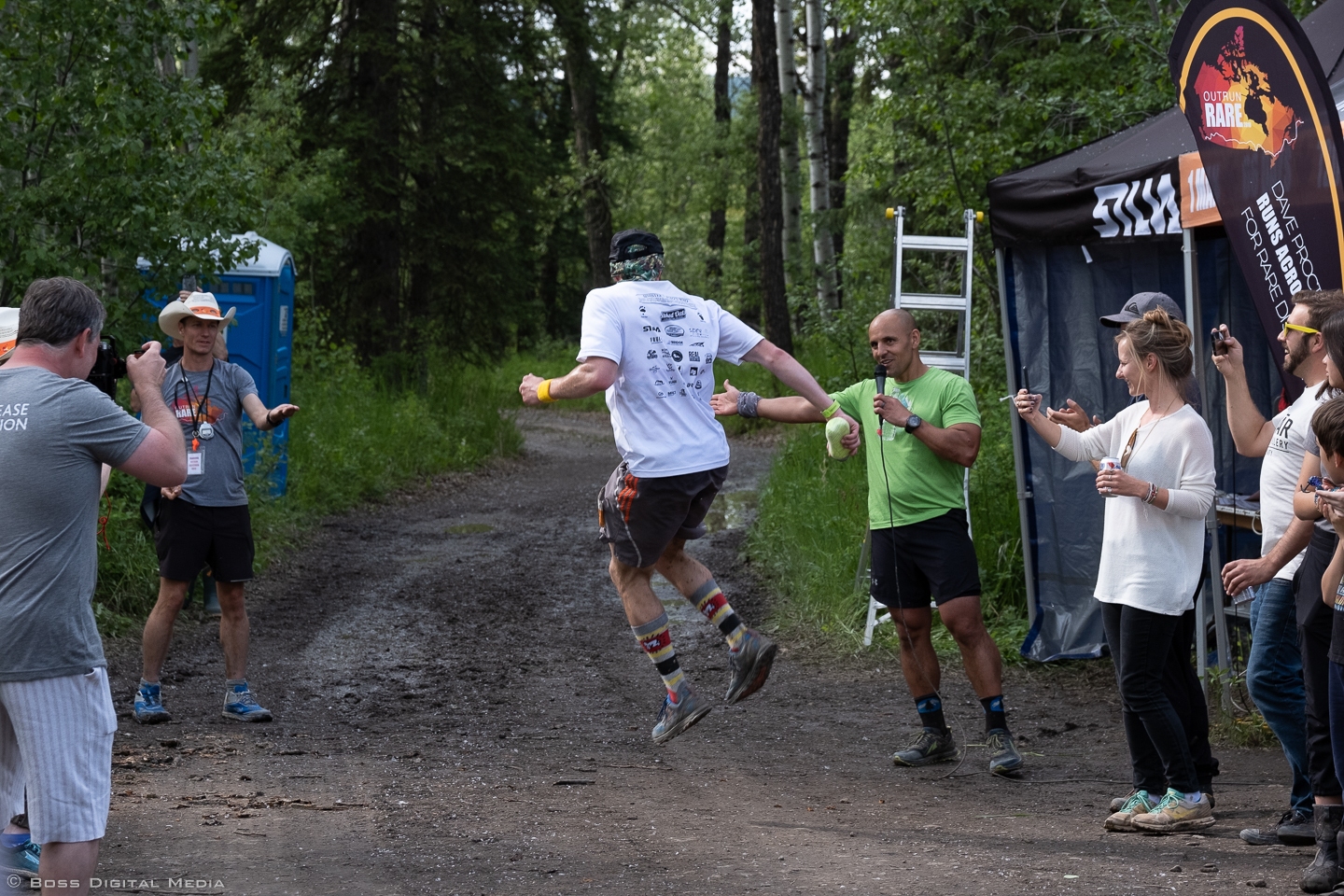
Kevin, second place, announcing Matt the winner at the end of loop 32
I had no idea heading into this race just how much I would love the format. It’s so simple, yet so subtly complex; so boring, yet so full of surprises. I can usually explain to others why I love ultras by leaning on the fact that they often take place in beautiful locations, traversing incredible trails up in the mountains. This was the complete opposite: a flat, muddy loop around a farm. And yet, that only added to the charm. This was truly one of the most unique and special races I’ve ever run. I have little doubt I will be back next year, maybe even with an eye on that golden ticket to Big’s.
But perhaps most importantly, I can finally say I’ve run 100 miles. I now have the confidence I need to signup up for my first true 100 miler. I currently have my eyes on the mountainous Cascade Crest 100 in Washington next summer. It’s a special race to me because much of it is run on the PCT and because it was there that I met my hero Hal Koerner, 55 miles into the race, off course in the middle of the night (a story for another time). But no matter which race I eventually choose, the mythical 100-mile distance is now a little less of a mystery.
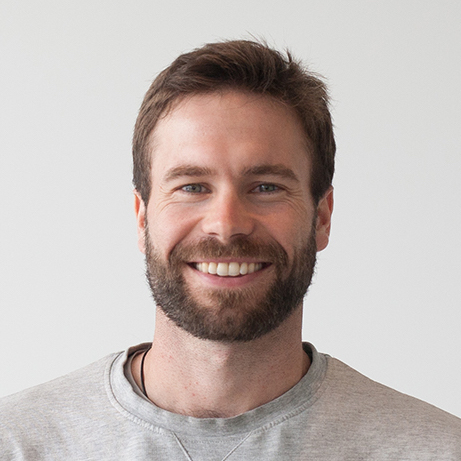
Ross Noble is a software developer, ultrarunner, podcaster and former-van-dweller with a passion for the outdoors. He writes about running, cinema and anything else that interest him.
Montreal, QC
